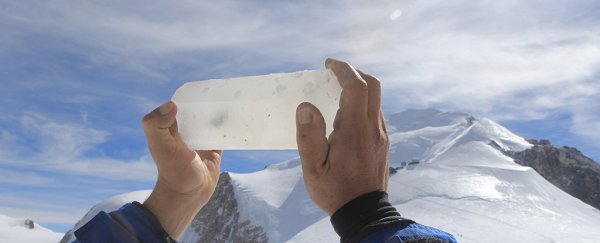The ongoing effects of climate change mean that the amount of ice covering Earth is shrinking, and a team of scientists has taken it upon themselves to store and catalogue as many types of as possible before it's gone.
You might not think that ice blocks from different parts of the world are all that different, but they contain invaluable data about long-term changes in the surrounding temperature and air quality - information that's essential to understanding our planet.
Researchers from the Protecting Ice Memory project, drawn from the IRD (Institut de Recherche pour le Développement), the CNRS (Centre National de la Recherche Scientifique) and the Université Grenoble Alpes in France, are launching the mission this month by taking a sample from the Mont Blanc massif in the Alps.
"In the coming decades, or even centuries, this ice archive will be invaluable – be it for entirely unprecedented scientific discoveries or for understanding local changes in the environment," said climatologist Jean Jouzel, former vice chair of the Intergovernmental Panel on Climate Change (IPCC).
Once extracted, the blocks of ice are going to be transported through a 'cold chain' of ships and vehicles to an underground ice bunker at a research station in Antarctica.
Eventually, the team wants to have several dozen ice cores, each measuring a hefty 130 metres in length, and stored in the snow cave at temperatures of –54°C. It's been described by the scientists as "the most reliable and natural freezer in the world".
While the primary participants in the archive operation are from French institutions, the project was conceived of in Italy, and has received support from Germany, Austria, Switzerland, Brazil, the US, Russia, China, Nepal and Canada.
The team says it was a sudden rise in glacier temperatures across the world that prompted them to take action, and the project was partly inspired by the 'doomsday' seed vault in Svalbard - a repository of millions of seeds collected from across the globe.
The thinking behind the seed bank is that should any types of plant be wiped out, seeds from the vault can be used to restore them. In fact, some withdrawals have already been made for that very purpose.
In a similar vein, keeping the enormous ice cores safe at the Concordia station in Antarctica will give researchers backup copies of the state of these glaciers that can be studied if something happens to the originals. Not only will they teach us more about the history of Earth's climate, they could also point towards how it's going to change in the future.
The first three cylindrical cores are set to be extracted from the Col du Dôme - some 4,300 metres or 14,108 feet up Mount Blanc - on August 15. A helicopter will get them back down to the valley floor, and analysis on one core will begin immediately.
"Our generation of scientists, which bears witness to global warming, has a particular responsibility to future generations," said one of the project initiators, Carlo Barbante from the Ca' Foscari University of Venice.
Hopefully we just buckle down and start to take better care of our planet in the future, because all the libraries in the world can't save us if we don't.
